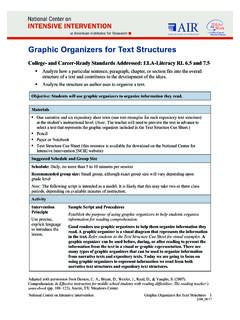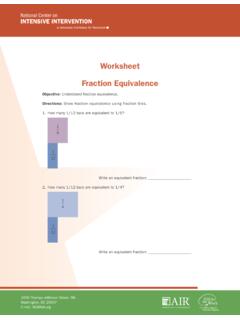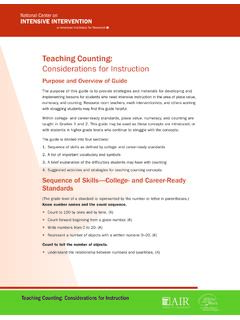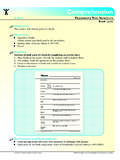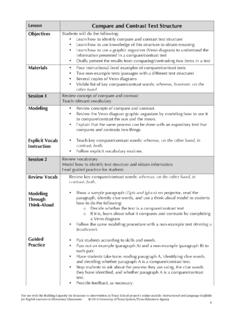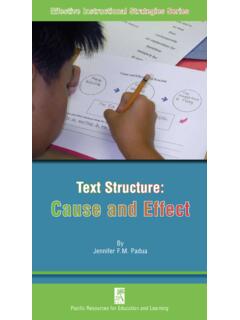Transcription of Identifying Narrative and Expository Text Structures
1 Identifying Narrative and Expository Text Structures Adapted with permission from the Meadows Center for Preventing Educational Risk. Denton, C. A., Bryan, D., Wexler, J., Reed, D., & Vaughn, S. (2007). Effective instruction for middle school students with reading difficulties: The reading teacher s sourcebook (pp. 108 132, 313 317). Austin, TX: Meadows Center. Retrieved from National Center on Intensive Intervention Identifying Narrative and Expository Text Structures 1 0447_02/17 College- and Career-Ready Standards Addressed: , Analyze how a particular sentence, chapter, scene, or stanza fits into the overall structure of a text and contributes to the development of the theme, setting, or plot.
2 Objective: Students will learn to differentiate Narrative and Expository texts . Materials Three Narrative short texts and three Expository short texts at appropriate instructional level. Pencil. Paper or notebook. Text structure Cue Sheet (see below). Suggested Schedule and Group Size Schedule: Daily, no more than five minutes to 10 minutes per session. Recommended group size: Small group (four to five students in lower grades; up to 10 students in upper grades). Note: The following script is intended as a model. Activity Intervention Principle Use precise, explicit language to introduce the lesson and critical concepts.
3 Sample Script and Procedures Today, we ll be learning about text structure , which is something good readers use to help them understand what they read. Text structure is the organization of text. What is text structure ? (The organization of text) Deliver new information explicitly and in smaller chunks compared with less intensive instruction. There are two main categories of text: (1) Narrative text, and (2) Expository text. Each time we encounter new text we will decide what type of text Narrative or Expository it is. Ask questions frequently to check for understanding. What are the two types of text we ll be talking about today?
4 ( Narrative and Expository .) National Center on Intensive Intervention Identifying Narrative and Expository Text Structures 2 Provide a Narrative text and an Expository text at the students instructional level. The purpose of Narrative text is to entertain the reader or present a story. Narrative text will often use a text structure that includes a beginning, a middle, and an end of a story. A novel is an example of a Narrative text. What is the purpose of Narrative text? (To entertain the reader or tell a story.) That s right. Narrative text is intended to entertain the reader or tell a story. The purpose of Expository text is to inform the reader of an event or provide general information.
5 What is the purpose of Expository text? (To inform the reader or provide information.) That s right, Expository text informs the reader or provides information. Your science book is an example of an Expository text. One tricky thing about Expository text is that it can use different text Structures within one text, so we ll have to watch out for that. Model think-aloud procedures to demonstrate how to differentiate text types. Preview the Narrative text with the students. Identify the characteristics of the text to help determine the text type. Have students use paper and pencils to record notes. Let s look at this Narrative text together.
6 Watch and listen as I think out loud and look for the features of a Narrative text. First, I ll look to see how the text is organized. When previewing Narrative text, I ll look for the following features. Write these on the board: a. Setting b. Characters c. Conflict d. Rising action e. Climax f. Falling action g. Resolution Let s preview the Narrative text passage together and look for these features. The Narrative text features listed above may or may not be present in the Narrative text passage presented to the students. To efficiently locate the features during modeling, preview the text to highlight which features are present and where they are located in the passage.
7 Now, let s look at the features of the Expository text to help us identify how it is organized. When previewing Expository text, we should look for the following features to identify it as an Expository text. Write these on the board: a. Titles b. Headings c. Subheadings National Center on Intensive Intervention Identifying Narrative and Expository Text Structures 3 d. Boldface words e. Charts f. Tables g. Diagrams h. Graphics Let s preview the Expository text passage together. The Expository text features listed above may or may not be present in the Expository text passage you present to the students. To efficiently locate the features during modeling, preview the text to highlight which features are present and where they are located in the passage.
8 Use study aides to provide structure for practice. Introduce the Text structure Cue Sheet to serve as a guide for the students to use while they identify text types. Use the cue sheet to review the Narrative and Expository text purpose, text Structures , definitions, and signal words. Let them know they will learn more about the graphic organizers section in another lesson. Remember, Narrative text structure uses a story structure that includes story elements, such as setting, characteristics, conflict, plot (rising action, climax, falling action), and resolution. Point to items on the cue sheet. Narrative text Structures may also be easier to remember because the structure follows a story with a beginning, a middle, and an end.
9 Expository text Structures present information to the reader using different Structures . Expository text structure may have up to six different subtypes of text Structures . We will learn more about those subtypes in another lesson. Allow opportunities for paired practice and provide feedback. Now you ll work with a partner to determine whether the passages I m about to hand out are Narrative or Expository passages. Group the students in pairs. Hand out the second Narrative and Expository passages. Provide a few minutes for students to discuss possible text differences. Monitor the students discussions and remind them that it is okay to change their initial answers after their conversations with their partners.
10 The teacher might select a few students to share their answers and thinking as a model for the whole class. Allow opportunities for independent practice and provide immediate feedback. Hand out the third Narrative and Expository passages. Allow the students an opportunity to work independently while providing supportive practice. Ask students to identify the text type of each Narrative and Expository passage, and prepare students to share why they believe the passages are either Narrative or Expository . Ask students to use paper and pencils to record the text types and to explain why they think the passages are those particular text types.

